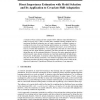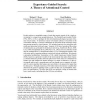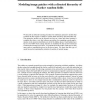101
Voted
NIPS
2007
15 years 2 months ago
2007
Much of human knowledge is organized into sophisticated systems that are often called intuitive theories. We propose that intuitive theories are mentally represented in a logical ...
108
click to vote
NIPS
2007
15 years 2 months ago
2007
Recently, we have introduced a novel approach to dynamic programming and reinforcement learning that is based on maintaining explicit representations of stationary distributions i...
88
Voted
NIPS
2007
15 years 2 months ago
2007
This article discusses a latent variable model for inference and prediction of symmetric relational data. The model, based on the idea of the eigenvalue decomposition, represents ...
110
Voted
NIPS
2007
15 years 2 months ago
2007
Reliably recovering 3D human pose from monocular video requires models that bias the estimates towards typical human poses and motions. We construct priors for people tracking usi...
105
Voted
NIPS
2007
15 years 2 months ago
2007
A situation where training and test samples follow different input distributions is called covariate shift. Under covariate shift, standard learning methods such as maximum likeli...
70
Voted
NIPS
2007
15 years 2 months ago
2007
Recent research has studied the role of sparsity in high dimensional regression and signal reconstruction, establishing theoretical limits for recovering sparse models from sparse...
98
Voted
NIPS
2007
15 years 2 months ago
2007
Current computational models of bottom-up and top-down components of attention are predictive of eye movements across a range of stimuli and of simple, fixed visual tasks (such a...
46
Voted
NIPS
2007
15 years 2 months ago
2007
91
Voted
NIPS
2007
15 years 2 months ago
2007
We present an efficient generalization of the sparse pseudo-input Gaussian process (SPGP) model developed by Snelson and Ghahramani [1], applying it to binary classification pro...
NIPS
2007
15 years 2 months ago
2007



